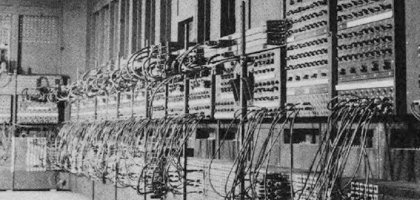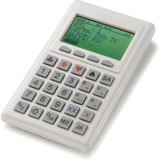 For a chance, a blog about bridge scoring, rather than about the game of bridge itself. If you are not a tournament director or don’t have an IT background, you’ll probably find this pretty boring.
For a chance, a blog about bridge scoring, rather than about the game of bridge itself. If you are not a tournament director or don’t have an IT background, you’ll probably find this pretty boring.
Summary:
If this idea is implemented, you simply walk into the club and you are automatically registered for the game. The phone in your pocket will tell you where to go for round 1. You enter the scores on your own phone, when you walk out, the results are visible on its display too. Expensive? No, in fact, you pay about 1/20th of what an average club spends nowadays on computer equipment. Great, isn’t it? If you want to know the details, read on.
About the title: A new trend in office computing is known as BYOD, or bring your own device. The idea is quite simple. Instead of providing a standard machine, in the BYOD model, each user can select his own favorite model laptop, phone or whatever. This has an obvious advantage: each user can select his favorite device. Want a traditional PC? Get a Dell. Prefer a Unix flavor? Download your favorite linux distribution. Prefer a tablet? Get an iPad. The BYOD model improves productivity as each user gets to work with his favorite device rather than being forced to work with something he doesn’t like. There is a lot more to say about BYOD, but that is for business blogs, this blog is about bridge and the mnemonic is BYOBm, which obviously stands for Bring Your Own BridgeMate.
Computers at a bridge game:
When I started to play bridge in the late 1970’s, practically all clubs used to score the games by hand. Usually with a group of folks all scoring a few boards and then everybody getting together to add things up. That typically took half an hour for a medium sized club game, larger clubs often provided the scores only days after the event. Things have changed over the years. First personal computers became cheaper and clubs could afford to have an (old) PC in the clubhouse. That speeded up things considerably. Data entry was still a problem though. Until some 15 years ago, we used to enter scores on travellers or score-slips. During or after the game, the TD entered all scores. That was a lot of work, with a fairly large probability of errors as not everybody writes that clearly. The second change came some 10 to 15 years ago, when people started to experiment with automated data entry. First attempts were with machine readable forms such as the Scanzo and BURP systems (neither one is in production anymore), but the breakthrough in the field was a device called the Bridgemate.
 The idea of the Bridgemate is simple. On each table, a box with a keyboard and display is placed. After each hand, the players enter the result and the data is transferred (wirelessly) to a base station. The base station feeds the data into the computer. The moment the last board has been entered, one can announce the winner of the game. Over the years, Bridgemates have been introduced at almost every club in the country and players have been become used to getting the results within minutes after the game.
The idea of the Bridgemate is simple. On each table, a box with a keyboard and display is placed. After each hand, the players enter the result and the data is transferred (wirelessly) to a base station. The base station feeds the data into the computer. The moment the last board has been entered, one can announce the winner of the game. Over the years, Bridgemates have been introduced at almost every club in the country and players have been become used to getting the results within minutes after the game.
Not for free: So-far, so good, but there is one small disadvantage to all this: it is not free. I was talking to the treasurer of a club sometime ago. His club had bought Bridgemates some years ago and they started to show some wear and tear, in the near future, he expected that they had to be replaced. Another thing he noticed was that the latest generation of Bridgemates have more functionality but are not backward compatible to the older model. All this added up to an investment of the order of 3,000 euro’s for the club. With about 100 members, that is a considerable investment.
I thought he had a point there. Now, I’m not questioning the price of the Bridgemate, which is around 90 euro’s per table. This may sound like a lot, but remember that these units have been developed (and can be used) for bridge only, which is by definition expensive. Production numbers are small, Bridge Systems has said that about 1,400 clubs use them, but then one only needs some 30,000 units. For consumer electronics, that is a small number, with the associated high production costs. Finally, the market for these devices is limited and Bridge Systems is already serving most of the market. So, we are looking at prices of 90 euro’s/table, to be written off in a couple of years and it is unlikely that this will ever change.
What does a Bridgemate actually do? Well, it isn’t much more than a device with a keyboard and a display, geared towards entering bridge scores. Entering the score involves 4 steps:
- The display prompts the user for the necessary data. The user enters the data with the keypad.
- His opponent checks the entry and presses the approve key.
- Data is transferred to the central computer, and the score in matchpoints (up to that point) is calculated. This is done by radio-communication.
- The Bridgemate displays the result and perhaps other information (such as other results on the board, where to go next, etc).
Now the next board can be played. Is there an alternative?
Actually, there is. Most players nowadays have a mobile phone. The majority of new phones sold these days are known as smart phones. That is the family of Apple’s iPhone, Samsung’s Galaxy, RIM’s Blackberry, and lots of other brands and models. What do these devices have in common?
- An Internet connection, through a technique known as WIFI, allowing for 2-way data communication.
- The possibility for the user to add applications, or apps, for whatever he wants to do.
- The possibility to enter and display data.
Put these two lists next to each other, and it becomes immediately obvious that an app on a smart-phone can provide the same functionality as a Bridgemate. What does it take to set this up in practice:
- An app for the various mobile devices, that the user has to download before the game.
- A device called a base-station. WIFI base stations are available from lots of vendors, for prices around 50 to 100 euro’s.
- A local network. This can be set up in software on any ordinary PC, in almost every case this can be the same as the PC doing the scoring.
- When the user walks in, he connects his phone to the local network. After each hand, he starts the app, enters the result, and sees the result.
What are the costs of this setup? Well, 100 euro’s for the hardware. It will take a bit of money to write the app, but as most of the elements needed can be found in the standard software libraries, the cost will be small, say a couple of days for somebody who has done this before. The software on the PC already has been developed and is usually included with the operating system. All that is needed, is software to communicate with the (existing) scoring program. That is perhaps a week of work for an experienced programmer. So, we might be looking at a month of software development, for 1,400 clubs, even at consulting rates of 200 euro’s/hour that is only 20 euro’s a club.
The advantage: For 120 euro’s per club, one gets exactly the same functionality that is now offered for 2,500 euro’s or more, using devices that players already have and bring anyway. A second advantage: Right now, adding functionality to the Bridgemates requires an upgrade of the hardware. With an app, that is no longer needed, simply download the new version and the new functionality is there.
The disadvantages: obviously, this requires everybody to bring his phone and the phone should be of a recent enough make. This is correct, but remember that only 1 player at a table needs a smart-phone for this to work, not all four. Most new phones are smart phones, with typical lifetimes of a few years for an existing phone, this issue will have solved itself in a year or two.
Also, smart phones can be used to store information (such as system notes) or to communicate with others. In a club game, I don’t see this as a problem but I agree that this is a problem at a major championship. The solution is easy though: for those events, buy the simplest and smallest tablet PC on the market and put (only) the app on that device. Tablet PC’s start at 70 euro’s nowadays for something that offers much more power than a Bridgemate.
Wrapping up...
If this idea is implemented in practice, in a year or so from now, you’ll walk into the club, switch on your phone and connect to the local network in the club. You have brought your own Bridgemate, or BYOBm. The app automatically registers you and provides your starting position. All this for about 1/20th of the cost of the current setup, making the club owner a happy man too.
Again, this is just an idea, but it is an idea that can be implemented today, using existing technology. Comments and feedback are more than welcome.
Disclaimer: Various trademarks have been used in this blog, all trademarks are recognized as such. I have no commercial or other interests in any of the companies mentioned in this article.
